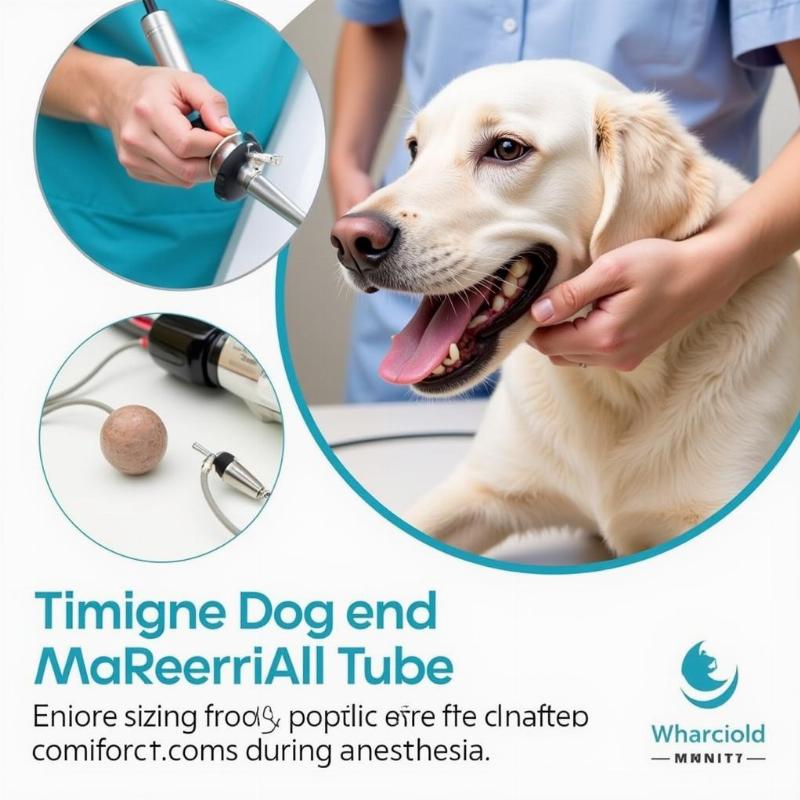Understanding the appropriate endotracheal (ET) tube size for your dog is crucial for safe anesthesia and respiratory support. While this is primarily a concern for veterinarians, knowing about dog ET tube size charts can help pet owners understand the procedures their furry friends may undergo. This guide provides a comprehensive overview of dog ET tube sizing, its importance, and factors affecting it.
Why is ET Tube Size Important?
Choosing the correct ET tube size is paramount for your dog’s safety during anesthesia. A tube that is too small can increase airway resistance, making it difficult for your dog to breathe. Conversely, a tube that is too large can damage the trachea or larynx.  Choosing the Right Size Endotracheal Tube for Your Dog
Choosing the Right Size Endotracheal Tube for Your Dog
Factors Affecting ET Tube Size
Several factors determine the appropriate ET tube size for a dog:
- Breed: Larger breeds generally require larger ET tubes.
- Weight: Weight is a key indicator of size and therefore influences tube selection.
- Age: Puppies and younger dogs have smaller airways than adult dogs.
- Individual Anatomy: Some dogs may have anatomical variations that require adjustments to the standard sizing.
How to Estimate ET Tube Size
Veterinarians typically estimate ET tube size based on the dog’s weight and breed. While a dog ET tube size chart offers a good starting point, it’s important to remember that these are estimates. The veterinarian will visually assess the trachea and may use several different tube sizes to ensure the perfect fit.
What to Expect During Intubation
Intubation, the process of inserting the ET tube, is performed after the dog is anesthetized. The veterinarian will gently open the dog’s mouth, visualize the larynx, and insert the lubricated tube into the trachea. Once in place, the tube is secured with tape or a tie. The veterinarian will then check for proper placement and connect the tube to an anesthesia machine or other respiratory support device.
Potential Complications
While rare, complications can occur during or after intubation. These may include tracheal damage, laryngeal edema, or accidental placement of the tube in the esophagus. Veterinarians are trained to minimize these risks and manage any complications that arise.
Post-Intubation Care
After a procedure requiring intubation, the veterinarian will carefully remove the ET tube once the dog is breathing on its own. Some coughing and gagging after extubation are normal. Your veterinarian will monitor your dog closely during recovery.
Conclusion
Understanding the basics of dog ET tube sizing empowers pet owners to better comprehend procedures their dogs may undergo. While the information provided here is for general knowledge, always consult with your veterinarian for any specific questions or concerns regarding your dog’s health. Remember, accurate ET tube sizing is essential for safe anesthesia and respiratory support.
FAQ
- What is a dog ET tube? A dog ET tube is a flexible plastic tube inserted into the trachea to maintain an open airway during anesthesia or respiratory distress.
- How is the correct ET tube size determined? Veterinarians use a combination of weight, breed, and visual assessment to determine the correct ET tube size.
- Is intubation painful for dogs? Intubation is performed while the dog is under anesthesia, so they do not feel any pain.
- What are the risks of intubation? While rare, potential risks include tracheal damage, laryngeal edema, and esophageal intubation.
- What should I expect after my dog has been intubated? Some coughing and gagging are normal after extubation. Your veterinarian will monitor your dog closely during recovery.
- Can I intubate my dog at home? No, intubation should only be performed by a trained veterinarian.
- Where can I find a dog ET tube size chart? While online charts can provide a general idea, they should not replace a veterinarian’s professional assessment.
Related Articles
Beautdogs.us is your trusted source for comprehensive and engaging information on dog care, breed specifics, and the best products for your furry friend. Whether you’re a new dog owner or a seasoned expert, we offer valuable insights and guidance to ensure your dog’s health and happiness. We cover a range of topics from nutrition and grooming to training and health, making us your one-stop shop for all things dog-related. Contact us today for expert advice! Email: [email protected], Phone: +1 501-555-7529. Visit Beautdogs.us for more information!